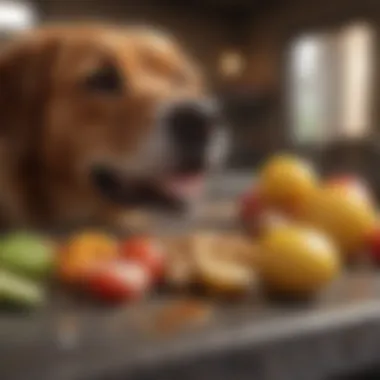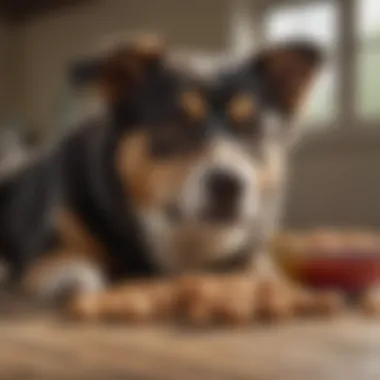Navigating Canine Nutrition: Foods Dogs Must Avoid


Intro
Understanding what food is harmful to dogs is essential for any pet owner. Many common foods can pose serious health risks if consumed by canines. This article identifies those foods, explains why they are dangerous, and suggests avoidance measures.
In today's world, dogs are often seen as members of the family. Thus, the responsibility of caring for their diet should not be taken lightly. With increasing information available about canine nutrition, this guide serves as a critical resource for veterinarians, biologists, and families.
We will explore various harmful foods, delve into their toxicity levels, and outline the symptoms that can arise from consuming these items. This information not only promotes awareness but also encourages responsible pet ownership. Knowing which foods to avoid can help prevent serious health issues and can greatly enhance a dog's quality of life.
Let's examine some of the basic concepts related to canine nutrition and the specific foods that should never be included in your dog's diet.
Prolusion
In the realm of canine care, understanding nutrition is paramount. Dog owners must recognize that not all foods labeled as safe for human consumption are suitable for their pets. This necessity for knowledge extends beyond mere curiosity; it poses real implications for the health and safety of dogs. Nutrition directly influences a dog's vitality, longevity, and happiness. By choosing appropriate foods, owners enhance their pets' quality of life. This guide aims to illuminate the often-overlooked aspect of harmful foods that dogs should avoid.
Importance of Dog Nutrition
Dog nutrition is foundational to their overall health. A balanced diet helps maintain ideal body weight, supports the immune system, and fosters robust energy levels. The absence of essential nutrients can lead to serious health issues. Common ailments linked to poor diet include obesity, diabetes, and digestive disorders. It is essential for dog owners to educate themselves about canine dietary needs. This knowledge enables them to make informed choices, ensuring their pets have a healthy and fulfilling life.
Overview of Harmful Foods
Certain foods, while benign for humans, can be detrimental to dogs. This section delineates various items that fall into the category of harmful foods. Recognizing these foods is crucial for any responsible owner. The consequences of canine nutrition missteps can be severe, including poisoning, organ damage, and even death. Moreover, awareness of these threats aids in creating a safe environment for dogs. An understanding of what foods to eliminate can significantly reduce the risk of unintended harm, ensuring dogs remain healthy and happy.
"Preventative education is the key to safeguarding your dog's well-being."
Consequently, the next sections will delve deeper into specific foods that pose risks to dogs, examining their toxicity and providing practical guidance for pet owners.
Common Toxic Foods for Dogs
Understanding the common toxic foods that dogs should avoid is vital for any responsible pet owner. These foods, which can be often found in many households, pose significant health risks. Recognizing these items can help prevent serious health issues in dogs. This section delves into specific foods that are harmful, their toxic properties, and the mechanisms through which they affect canine health.
Chocolate
Types of Chocolate
Chocolate can vary widely in types, including dark, milk, and white chocolate. Dark chocolate contains higher levels of theobromine, the compound responsible for its toxicity to dogs. Milk chocolate has less theobromine but is still dangerous. White chocolate contains only trace amounts but can still pose risks if consumed in large quantities. Understanding these distinctions is crucial. The main characteristic of chocolate toxicity is the cumulative interactions between chocolate type and quantity. Different types present different levels of risk to dogs, and pet owners should be well-informed.
Theobromine Poisoning
Theobromine poisoning is a serious concern for dog owners. This compound metabolizes slowly in dogs, leading to toxic effects. Symptoms can include vomiting, increased heart rate, and hyperactivity. The severity of symptoms correlates with the amount and type of chocolate ingested. For instance, even a small amount of dark chocolate can lead to severe health issues. Knowledge of theobromine poisoning can prepare owners to act quickly in case of accidental ingestion.
Onions and Garlic
Mechanism of Toxicity
Onions and garlic contain compounds that can damage red blood cells in dogs. This results in a condition known as hemolytic anemia. Dogs ingesting these foods may experience lethargy, vomiting, and diarrhea. The toxicity mechanism lies in the oxidative properties of these compounds, which are particularly harmful in sufficient quantities. Understanding this mechanism of toxicity is essential in recognizing the risks associated with these ordinary food items.
Symptoms of Damage
The symptoms of damage from onions and garlic can manifest slowly. Lethargy and weakness are often the first signs, followed by more noticeable symptoms like jaundice and pale gums. Owners should be aware that the damage to red blood cells can take days to weeks to become apparent. Early recognition of these symptoms can significantly affect treatment outcomes, making knowledge about these signs necessary for all dog owners.
Grapes and Raisins


Kidney Failure Risk
Grapes and raisins are commonly regarded as a healthy snack for humans but can be extraordinarily toxic for dogs. Consumption of even small amounts can lead to sudden kidney failure. The exact mechanism of how grapes affect renal function remains unclear, but the risk is significant enough to warrant extreme caution. It's essential for pet owners to avoid allowing their dogs access to these foods entirely.
Potential Quantity Dangers
The danger posed by grapes and raisins also varies based on the quantity ingested. Some dogs may react to just a few grapes, while others may consume more without apparent immediate harm but still face long-term effects. This uncertainty makes it critical for pet owners to err on the side of caution, preventing exposure entirely.
Xylitol
Sources of Xylitol
Xylitol is a sugar substitute commonly found in sugar-free gum, candy, and various baked goods. It is appealing to manufacturers for its low-calorie content. Unfortunately, xylitol is highly toxic to dogs, triggering a rapid insulin release that can lead to hypoglycemia. Awareness of products containing xylitol is essential for dog owners seeking to protect their pets from this hidden danger.
Effects on Blood Sugar
The effects of xylitol on blood sugar are dangerous and can be swift. Hypoglycemia can result in symptoms such as disorientation, seizures, and in severe cases, death. Dogs require immediate medical attention if they consume xylitol-containing products. Understanding these consequences can help owners make informed decisions about what to keep in their homes.
Avocado
Persin Toxicity
Avocado contains a compound called persin, which can be toxic to dogs in large quantities. While many people eat avocado safely, the same does not apply to dogs. Persin affects respiratory function and can lead to vomiting and diarrhea. The toxicity level varies depending on the part of the avocado consumed, with the flesh being less harmful than the pit or skin. Awareness of persin toxicity helps in maintaining a safe dietary environment for canine companions.
Safe Feeding Guidelines
While some dogs can tolerate a small amount of avocado, caution is paramount. Owners should avoid giving avocados in large amounts and refrain from offering the pit and skin. Monitoring the dog's reaction is also crucial when introducing any new food. Establishing clear guidelines for avocado consumption ensures health safety while allowing for nutritional variety.
Less Known but Dangerous Foods
Understanding which foods can potentially harm dogs extends beyond the commonly known toxic items. The less recognized but dangerous foods also pose significant risks to canine health. Awareness of these dangerous food items is crucial in preventing accidental poisonings. Owners can maintain their pets' wellbeing through education and vigilance regarding less obvious dangers.
Macadamia Nuts
Neurological Symptoms
Macadamia nuts are notably harmful to dogs, even in small quantities. When ingested, these nuts can cause various neurological symptoms. This includes weakness, tremors, and hyperthermia. The key characteristic of these symptoms is their sudden onset, which can worry pet owners. Immediate attention is necessary when such symptoms present, highlighting the need for dog owners to understand the specific risks associated with macadamia nuts. By being informed, owners can act quickly to reduce the potential severity of poisoning.
Recommended Actions
If a dog ingests macadamia nuts, there are immediate actions that owners should take. Key recommended actions include contacting a veterinarian as soon as possible. Clear communication of the amount ingested will help the vet determine the seriousness of the situation. Do not induce vomiting unless instructed, as this may not always be safe. The uniqueness of these actions lies in their ability to increase the chance of recovery and reduce long-term health effects.
Alcohol
Impact on Canine Health
The impact of alcohol on canine health can be severe and life-threatening. Dogs are far more sensitive to alcohol than humans. Even small amounts can lead to intoxication, affecting the liver and brain. This makes the topic of alcohol ingestion highly relevant when discussing hazardous foods. Alcohol can depress the central nervous system in dogs, leading to issues like disorientation, vomiting, and in extreme cases, coma. This is why dog owners must remain vigilant about where they store alcoholic beverages.
Signs of Alcohol Poisoning
Identifying signs of alcohol poisoning is critical for prompt medical intervention. Key signs include lethargy, sudden collapse, seizures, and slow or difficult breathing. The uniqueness of these symptoms lies in their ability to escalate quickly without treatment. By recognizing these signs early, owners can take necessary actions to seek veterinary assistance, which can be life-saving.


Coffee and Caffeine
Stimulant Effects
Both coffee and other sources of caffeine can act as stimulants that are harmful to dogs. The stimulant effects can lead to increased heart rate and nervous system overactivity, presenting serious health risks. The knowledge of these effects is necessary for dog owners and can contribute to informed dietary choices. High caffeine content can lead to severe reactions, underlining the importance of avoiding any form of caffeine around pets.
Doses That Are Dangerous
Determining doses that are dangerous is critical. Even a small amount of coffee or caffeine can be toxic to a dog. For example, as little as 20 mg per kilogram of body weight can cause symptoms of toxicosis. The uniqueness of this point is the variability in toxicity based on a dog's weight and breed. Understanding these doses can help owners prevent accidental ingestion of caffeine-containing products, ensuring a safer environment for their pets.
Other Foods to Watch Out For
Understanding the various foods that can pose risks to dogs is vital. Not all harmful foods fall into the mainstream categories often discussed. This section highlights some lesser-known yet equally dangerous foods. Recognizing these potential dangers allows dog owners to take preventative actions, ensuring their pets remain safe and healthy. It is crucial to stay informed and vigilant, as even common foods can turn harmful in certain contexts.
Fat Trimmings and Bones
Health Issues
Fat trimmings from meat may seem harmless, but they are problematic for dogs. Eating excess fat can lead to pancreatitis, a painful inflammation of the pancreas. This condition can manifest suddenly and with serious consequences. Symptoms include vomiting, lethargy, and abdominal pain. Moreover, some bones can splinter during chewing. This can cause lacerations or blockages in the digestive tract.
The high-fat nature of these trimmings raises concerns. Dogs enjoy the taste, but the health issues caused by unchecked fat consumption can make it a dangerous choice for pet owners. It's critical to provide lean cuts and avoid giving dogs leftovers of fatty meats. By understanding these health issues, owners can avoid putting their pets at risk.
Digestive Risks
The digestibility of bones is another significant concern. Some types of bones can be harmful to dogs. Cooked bones tend to splinter, leading to potential choking hazards. Splintered bones can also tear the dog's esophagus or stomach lining. This situation can quickly escalate to an emergency requiring veterinary assistance. Larger bones may seem safer, but they can still pose risks depending on the dog's chewing habits.
Digestive risks associated with fat trimmings and bones are important to consider. While dogs might have strong jaws, their digestive systems are not equipped to handle certain materials. Keeping this in mind can help owners make informed decisions. Ensuring safe and appropriate chew options is a vital part of responsible pet ownership.
Certain Fruits and Vegetables
Citrus Fruits
Citrus fruits like oranges and grapefruits can cause stomach upset in dogs. The high acidity in these fruits can be a deterrent. Even though they are common in human diets, they can create digestive discomfort for pets. Signs might include drooling or vomiting. While a small piece may not be dangerous, it is imperative to monitor how a dog reacts after consumption. The risks associated with citrus fruits warrant a cautious approach when it comes to feeding.
Some dogs may have a higher tolerance for acid than others. However, keeping citrus fruits to a minimum is prudent. Avoid exposing dogs to large quantities as a preventative measure. Understanding these potential reactions can help owners maintain their pets' health effectively.
Tomatoes
Tomatoes are another example of food to treat with caution. While ripe tomatoes may not be toxic in small amounts, the green parts of the plant contain solanine. This compound is harmful to dogs and can lead to toxicity. Symptoms may include weakness, confusion, and gastrointestinal distress. Given the risks, it’s sensible to avoid giving tomatoes to dogs altogether.
The unique feature of tomatoes lies in their varying toxicity levels, especially depending on the ripeness of the fruit. It makes them an unreliable choice for pet owners. Being aware of these distinctions can help mitigate risks and prevent accidental ingestion of harmful parts of the tomato plant.
"Not all fruits and vegetables are healthy for dogs. Always research or consult a veterinarian before introducing new foods to your pet�’s diet."
What to Do If Your Dog Eats Harmful Foods
Understanding the proper actions to take if a dog eats harmful foods is essential. The immediate response can greatly influence the outcomes of the situation. Timely recognition of potential poisoning symptoms can help in determining whether urgent action is necessary or if the situation can be monitored at home. This section outlines the critical steps a dog owner should take if their pet consumes anything toxic.
Recognizing Symptoms of Poisoning
Common Symptoms


Identifying common symptoms of poisoning is vital for early intervention. Some typical signs include vomiting, diarrhea, lethargy, and lack of appetite. In more severe cases, symptoms may escalate to tremors, seizures, or even loss of consciousness. These indicators help in quickly assessing whether your dog requires immediate medical attention. Thus, keeping track of your dog’s health is a popular strategy, as it leads to quicker reactions in emergencies. Awareness of these symptoms allows for timely care, which can prevent further complications.
Severity Assessment
Evaluating the severity of symptoms is another important aspect of responding to potential poisoning. Understanding how severe these symptoms are helps in deciding the necessary actions. For instance, mild symptoms like slight lethargy might allow for monitoring at home. In contrast, serious symptoms like persistent vomiting warrant immediate veterinary guidance. Thus, the unique feature of severity assessment lies in its ability to classify the seriousness of the condition. Accurate assessment helps lessen anxiety and aids in prioritizing the next steps.
Emergency Actions
Immediate Steps to Take
When a dog eats something harmful, the first actions taken can be crucial. Start by removing any remaining toxic substance from the dog's reach. If the dog is conscious and alert, it may be beneficial to induce vomiting, but only under guidance from a veterinarian. Time is often of the essence, and knowing what immediate steps to take can make a difference in survival and recovery rates. This information is beneficial in this article, encouraging quicker responses to improve pet outcomes.
Veterinary Assistance
Seeking veterinary assistance should always follow immediate actions. A veterinarian can provide expertise in matters of pet health that owners might not possess. They can offer guidance on whether to induce vomiting or what other treatments are necessary. Furthermore, even when symptoms seem mild, it's better to consult a professional since some effects might not be visible right away. Engaging veterinary services in these situations transforms the uncertainty into a manageable issue.
When in doubt, contact your veterinarian as they have the tools and knowledge to help.
Preventative Measures for Dog Owners
Preventative measures are crucial in safeguarding the health and well-being of dogs. Understanding the potential risks associated with harmful foods can help guide pet owners in making informed choices. The primary goal is to create an environment where dogs can thrive without the threat of toxic substances. This section discusses the importance of education and establishing safe practices at home.
Educating Family and Friends
Communication is Key
Clear communication about pet safety is essential. Informing family and friends about foods that dogs should avoid ensures everyone is on the same page. This collective awareness helps prevent accidental feedings of harmful items. One key characteristic of effective communication is consistency. Regular discussions reinforce the importance of healthy canine diets. It is beneficial in this article as it aids in creating a shared responsibility for the dog's nutrition.
The unique feature of this approach is its inclusive nature. Involving everyone who interacts with the dog fosters a sense of vigilance. This collaboration means there are more eyes on the lookout for potential dangers. However, there is a challenge in ensuring that everyone remains informed, as dietary guidelines can change.
Avoiding Dangerous Situations
Avoiding dangerous situations revolves around proactive management of a dog's environment. This means being aware of where potentially harmful foods are located and taking steps to secure them. A key characteristic of this strategy is preventive action—establishing rules around food storage and handling.
This approach is beneficial in this article as it minimizes risks before they become issues. By taking these precautions, pet owners can significantly reduce the likelihood of accidents. The unique aspect of avoiding dangerous situations is that it combines education with environmental control. This can lead to fewer emergencies and peace of mind for pet owners. Nevertheless, it does require constant vigilance and effort to maintain a safe environment.
Creating a Safe Space for Pets
Storing Hazardous Items Away
The storage of hazardous items is a fundamental aspect of creating a safe environment for dogs. This involves identifying which foods pose a risk and ensuring they are out of reach. A key characteristic here is the physical separation of harmful items from areas accessed by dogs.
The benefit of this practice is clear; it minimizes direct access to risks. For this article, it offers straightforward, actionable advice for pet owners. The unique feature of storing items away is its immediacy—it provides instant security without needing constant observation. However, it does necessitate an initial effort to reorganize spaces and identify hazards.
Regular Kitchen Audits
Conducting regular kitchen audits is essential for maintaining a safe space for pets. This practice involves routinely assessing food items and storage locations. A key characteristic of kitchen audits is their systematic approach to safety; they encourage regular checks.
The benefit of this method lies in its preventive nature, helping spot potential dangers before they can harm a pet. This practice is relevant to the article as it promotes ongoing vigilance rather than one-time fixes. The unique aspect of regular audits is that they generate a habit of safety awareness among pet owners. On the downside, they may be overlooked in busy households, but establishing a schedule can help ensure they get done.
Closure
In summary, concluding a discussion on canine nutrition particularly focusing on foods that dogs should avoid is essential for pet owners. This section emphasizes the vital role of understanding the toxicity of certain foods. Highlighting the risks associated with harmful items can significantly impact a dog’s health.
The primary benefit of this conclusion is to reinforce awareness among dog owners. It is not just about what dogs can eat, but more importantly, about what they should not consume. This understanding helps in preventing potential health crises that might arise from negligence.
Specific considerations include the importance of thorough education on dog nutrition. Knowing which foods are unsafe, such as chocolate, grapes, or even certain vegetables, can be lifesaving. Also, it's crucial to remember that the effects of these harmful substances vary based on the dog's size, age, and overall health.
Another point to consider stems from the shared responsibility between veterinarians and pet owners. Regular veterinary check-ups and discussions about diet can foster a better environment for a pet's health. Ultimately, commitment to a dog's nutritional needs is a multi-faceted approach that combines knowledge, preventive care, and responsible pet ownership.







